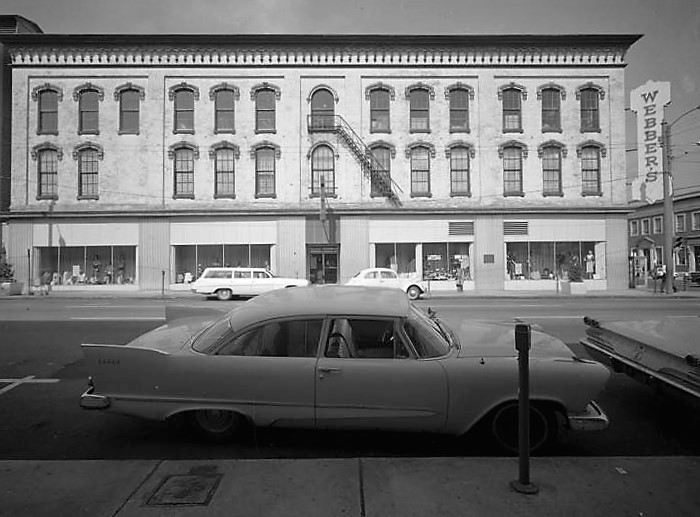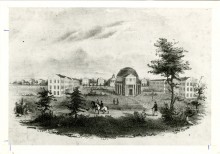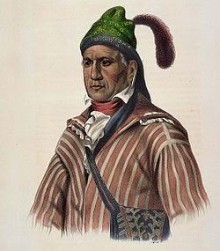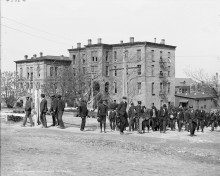John Wilkes Booth was in the first play held at the Old Montgomery Theatre
The old Montgomery Theatre described here became the Webber Department Store and recently a renovation was taking place to restore the building when it partially collapsed. See story Montgomery Theatre partially collapses. I do not know it’s status at this time.
PASSING OF THE OLD MONTGOMERY THEATRE
Captain Frank O’Brien tells of early days of the Playhouse, Some of the Players and Stirring Scenes enacted there during War Days
BY
Frank P. O’Brien 1901
On invitations of my good friends, Mr. Jake Wells and the Hirscher Brothers, managers of “The Grand”—the new temple of the Drama—in Montgomery, I was present at the opening of that beautiful house Thursday night, November 14.
Fondest Memories
The almost constant “buzz” of complimentary remarks on all sides, singing the praises of the new candidate for public favor, sounded to me like the death knell of that old favorite on Perry Street, around which clusters the fondest memories of my boyhood days, and still small voices cry out as the stiffening fingers of memory slowly and softly turn back the pages to those stormy days “lang syne”, for within its hallowed walls I spent many happy moments as assistant scenic and fresco painter, apprenticed to my dear old friend Peter Schmidt from the first of February, 1860, to the ninth of January, 1861, when with other venturous spirits, I left for Pensacola, as a member of the Independent Rifles, Captain Bob Farris commanding, under orders from Governor A. B. Moore.
 Webber building (photograph by John E. Scott, Alabama Department of Archives and History)
Webber building (photograph by John E. Scott, Alabama Department of Archives and History)
Sketch for the Montgomery Advertiser
In giving to The Advertiser this little sketch I am forced to write in the first person, I can tell the story in no other way. It has been erroneously asserted by many, among the number my late friend Stuart Robson, that the Montgomery Theatre was erected in 1854. The building was started early in the fall of 1859 under the supervision of Colonel Daniel Cram, designer, and architect, and at that time Superintendent of the Montgomery and West Point Railroad. The owner was Colonel Charles T. Pollard, the President of the same railroad. The building was erected by Messrs. B. F. Randolph and A. R. McLelland, McLelland doing the wood work and Randolph the brick work and plastering. The joiner and inside wood work was executed by George and Ed. Fletcher, whose shop was on the opposite side of the street. As stated by Wade McBryde, the mason labor was composed entirely of negro women, the property of Mr. Randolph, the brick contractor.
John Wilkes Booth was in cast of First Play at new Montgomery Theatre
The theatre was first opened to the public the night of October 14, 1860. The bill presented was Richard Brinshy Sheridan’s “School for Scandal,” and the “Persecuted Dutchman.” The cast of “School for Scandal” was composed of the following many of whom have written their names high in the dramatic firmanent: John Wilkes Booth, (who until that season had played under the “nom de theatre” of John Wilkes), John W. Albaugh (now owner and manager of Albaugh’s Washington Theatre), Jimmie Ward, Samuel K. Chester, Harry Watson (who later became an Episcopal clergyman of note in Wisconsin), Frank Keller, Billie Sheldon, Jimmie Lewis, (for many years a member of Daley’s New York company), Charles Morton, Harry DeCourcey, Joe Lewis, Mary and Emma Mitchell, sisters of Maggie Mitchell (the former, at present the wife of John W. Albaugh), Mrs. David Hanchett, Mollie Williams, Julia Nelson, and Kate Hafferning, Later on the company was strengthened by the addition of Joe Taylor, his wife and Master and little Miss Ophelia Lewis, as juvenile members.
Executive Staff
The following composed the executive staff: Mat Canning, (late of Crisp and Canning), Lessee and Manager William Crenshaw, Treasurer; John Albaugh, Stage Manager; William Lester, Prompter; Peter Schmidt, Scenic Artist; Frank P. O’Brien, Assistant Scenic Artist; EU Lewis Properties; Mrs. EH Lewis, wardrobe woman and Charles W. Pickett, Stage Carpenter.
Cradle of the Confederacy
Montgomery is often referred to—and justly so—as the “Cradle of the Confederacy”, The spot on the portico of the State Capitol building indicated by a Star, is proudly pointed out as the place where our illustrious-leader,- Jefferson Davis, stood when the oath of office was administered, which placed in his hands the destinies of the “Storm Cradled Nation.”
An unpretentious two story building on Lee Street is pointed out as the “White House” of the Confederacy, where for a short time Mr. Davis and his family resided; yet I question if there are a dozen people in Montgomery today who are aware of the fact that within the four walls of that old Theatre on Perry street were enacted scenes which led up to the formation of that tempest tossed Nation, which breathed and burned and after four years of suffering and privation went down at Appomatox surrounded by a history made glorious by deeds of heroism unparalled in the annals of any country.
The old house was the home of stirring incidents and patriotic narrations in those gloomy days when the spector of discontent hovered over our land, and was the anchorage of unrest which preceded the hours that marked the formation of a government which we all hoped would “take her stand among the Nations of the Earth.”
From the stage of that old theatre during the latter part of November and December—messages were given out to a storm torn country by such illustrious- men as Alexander Stephens, Howell Cobb, Robert Toombs, William L. Yancey, Ben Hill, Thos. H. Watts, James H. Clanton, Gen, J. H. Holtzclaw, Col. Seibels and many others whose lives and property were sacrificed on the altar of country and who have long since “crossed the river.”
Overt act in theatre
An incident occurred that night of December Nineteenth 1860, in that theatre which was heraled (sic) all over the country as the first overt act of treason in the South. (South Carolina seceded the next day).
A beautiful flag of blue silk, with a single star in the center, was presented to Sam Harris, a young attorney, by Miss Maggie Mitchell, a member of the company, Mr. Harris, afterwards became Right Rev. Samuel S. Harris, Bishop of the Episcopal diocese of Michigan, Miss Mitchell one of the most renowned actresses on the American Stage; both having reached the top of the ladder in their chosen profession.
The feature which inscensed (sic) our erst-while enemy—connected with the presentation—was the fact that the young actress dragged the Stars and Stripes from the right hand box and trampeled it under foot as she presented the lone star flag to Sam Harris. She evened up later on, however, by administering the same dose of medicine to the “Bonnie Blue Flag,” on a far-away northern stage.
Invited guests attended a magnificent banquet
After the presentation of the flag and the dismissal of the audience, the stage was cleared and the company and a few guests were invited to a magnificent banquet given by the resident Manager, Mat Canning. Among the invited guests as I remember them now, were Mr. Harris, Mike L. Wood, (Mr. Harris’ brother in law), Charley Virgin, Ed. J. Lee, Dana Hubbard, Wade McBryde, Bob Bass, and Harry Mettenheimer; Col. Mike Woods, Ed. J. Lee, of that number including the writer alone survive.
Paintings of several treasonable characters
The war ending early in sixty-five and with hundreds of others I returned to Alabama determined to make the best of the situation. While—Micawber like—waiting for something to turn up, Col. Charles T. Pollard, still owner of the theatre, employed me to paint out several scenes on the stage and two or three designs in the front of the auditorium—painted there by Harry McCarthy, a “rebel” actor and embryo scene painter—which our would be masters and so called conquerors designated as of a treasonable character.
When the house was ready for use I was again employed by the Colonel—to manage it for him, in which capacity I served him until the close of the season of 1867-8, when other engagements forced me to resign and the theatre was leased to Messrs. J. A. Diaz and Jim Wells (of Soda Water fame,) who were succeeded by the late George F. McDonald who in turn was displaced by Jake Tannenbaum, now a citizen of Mobile. Mr. McDonald erected the treatre known as the Bijou on Bibb Street.
After the War
The first company to appear at the old house at the close of the war, was organized in New York by Frank Bates and Col. A. B. Tidmarsh, Bates was the husband of Ella Wrenn, a once famous English commedienne; The company was composed of the following clever people: Frank Bates, Oliver Wrenn, Fred Wrenn, James Keith, Ned Thorne, George Stuttz, Eliza Wrenn, Ella Wrenn, Martha Wrenn, Kate Slocomb,. and Harriet Custar.
Again the old theatre became a storm centre; as from the initial opening late in September, 1865 until the removal of “Steele’s Army corps,” late in October, scarcely a night passed that did not witness a clash between detachments of the army of occupation and small bodies of returned paroled Confederates. There are several citizens living in Montgomery to-day, who will remember that it was a very rare thing to see a woman in the theatre parquette floor under any circumstances whatever.
Fight with Indians
I remember that on one occasion a difficulty was started on the parquette floor by a detachment of Indian members, if I remember correctly, of a regiment commanded by General Healy and Billie and Henry Porter and a number of their friends. The combatants commenced shooting at each other, and I turned the interior lights out and immediately the audience hastily left the house. The theatre was quickly emptied and, in a measure, order was restored.
The Porter boys were so incensed at the cowardly attack made on them, that they quietly located their enemies, from sundry remarks, and followed them when they started to camp which was located in a portion of Wilson’s grove and on the large “Sayre” lot adjoining the residence of Mrs. Ann R. Thiess the mother of Wade McBryde. As the Indian soldiers reached the old “Belshaw” corner, the shooting began.
Several of the Indians were wounded and scattered, several running down Commerce street. Just in front of Hall, Roses and Roberts old store, a stand was made by three or four Indians and an officer who seemed to be in charge, and here it was that Billie Porter shot at the Yankee officer—missed him—and killed his own brother Henry Porter. After this sad affair the trouble between the “ya riltees” ancl our boys became less frequent.
Sustained companies for an entire season
To me it is almost incomprehensible and to the theatre-goers of the present day it will sound improbable, that Montgomery with a population of less than twelve thousand inhabitants could sustain companies for an entire season, and at prices that would be considered ruinous to the traveling manager of the present day. Such is a fact, during the season of 1856-66, 1866-7 and 1867-8, the following Opera companies played weekly engagements to crowded houses and at profits that would delight the souls of the average syndicate manager of the present day.
During the season above named the following companies played weekly engagements every year. The Susinii and Ghionii Italian Opera Company.—Pierre Bernard and Caroline Richings English Opera Company. The Franz Himmer-Frederici German Opera Company, and the Alice A. Oates Opera Bouffe Company. Those companies would average fifty people in the cast exclusive of an orchestra of usually fifteen pieces augmented by from five to eight local musicians, and in those days the local musicians of Montgomery were artists in their various lines, as witness the names, Etora Barilli, Eliadora Camp, Joseph Schmit, Emile Karsh, Henry Meyer, Salli Dreyer, and though not least Fritz Hille, for organist at the Catholic and Baptist churches in Montgomery.
Some famous actors
On the old stage, the year of its opening there appeared the following celebrated actors and actresses: Edwin Forrest, Edwin Booth, Lester Walleck, Mr. and Mrs. James Walleck, Mr. and Mrs. W. J. Waller, in their celebrated play—”The Duchess of Malfi”, Kate and Alice Battman; Charlotte Cuchman, Maggie Mitchell—in the ever popular drama, “Fanchon, the Crickett,” and the great melo-dramatic English actor, Charles W. Roberts, in his spectacular production of the “Corsican Brothers.”
Since the close of the war, Jefferson, Booth, Forrest, Salvini, Mansfield, Lawrence Barrett, McCulloch, Ristorii, Bernhardt, Juanacheck Rose and Charles Coghlan, Emma Abbot, Annie Pixley, Robson and Crane and many other dramatic lights known to fame, have delighted Montgomery audiences.
The curtain ‘rung down’ in the old play-house
Wednesday night, November thirteenth, the curtain was “rung down,” in the old play-house to give way to one of more modern construction. The soft glow of unforgotten scenes alone is left to me, and many whose hearts have throbbed with hope for the future years, as nightly we ascended the broad stairs from the street, to listen to and witness scenes of comedy, music and tragedy. Thus is marked the passing of the glory of the old Montgomery theatre. It was erected at a time as shown herein when this Union was in the throes of uncertainty, it closes at a period in the history of our beloved State which marks an era of prosperity and development gratifying to the heart of every citizen who claims Alabama as his home.
A cursory reading of a dear, departed old friend— Lucian Walker gives me an idea in closing this sketch which saddens me as no doubt it does every man to whom the old house has brought joy unalloyed. In the sight of many of us a rainbow will span the old play-house in those quiet hours, and hope and cherish treasures of sweet recollection soothe. There is not one of us who has not gone up the wide stairs loving, and come down them loving the more. There is not one of us who has left some weight of the soul there and never returned to claim it.
Vale! old house, the ghostly shadows of scenes long to be remembered will continue to hover within thy hallowed walls ’till the inevitable march of progress hastens thy destruction.
(Note: I do not know the status of this building at this time, but the excellent organization of Landmarks Foundation in Montgomery, Alabama probably can answer any inquires)
SOURCE
(File in the State Department of Archives and History, Montgomery, Alabama. See: The Montgomery Advertiser, Montgomery, Alabama Sunday, November 24th, 1907. Volume LXXVIII, Page 3, Col 1-2-3, Book 3447. By |Frank P. O’Brien – published in The Alabama Historical Quarterly, Vol. 03, No. 01, Spring Issue 1941
ALABAMA FOOTPRINTS Statehood: Lost & Forgotten Stories presents the times and conditions they faced in lost & forgotten stories which include:
- Who Controlled And Organized The New State of Alabama?
- Tuscaloosa Had Three Other Names
- Chandelier Falls & Capitol Burns
- Alabama Throws Parties For General LaFayette
- Francis Scott Key Was Sent to Alabama To Solve Problems





Interesting.
It has not been torn down yet. It is still propped up for now.